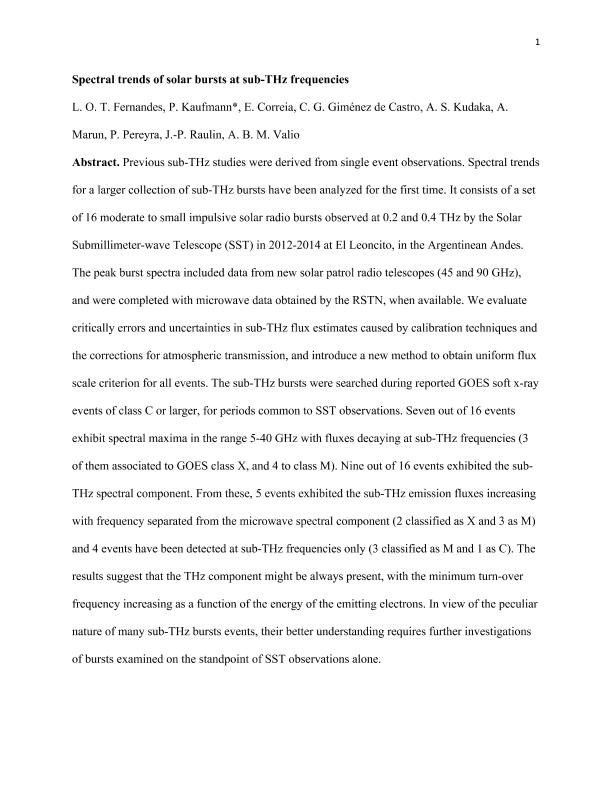Mostrar el registro sencillo del ítem
dc.contributor.author
Fernandes, L. O. T.
dc.contributor.author
Kaufmann, Pierre

dc.contributor.author
Correia, E.
dc.contributor.author
Giménez de Castro, C. G.
dc.contributor.author
Kudaka, A. S.
dc.contributor.author
Marun, Adolfo Hector

dc.contributor.author
Pereyra, Pablo Florencio

dc.contributor.author
Raulin, J. P.
dc.contributor.author
Valio, A. B. M.
dc.date.available
2018-10-24T20:19:55Z
dc.date.issued
2017-01
dc.identifier.citation
Fernandes, L. O. T.; Kaufmann, Pierre; Correia, E.; Giménez de Castro, C. G.; Kudaka, A. S.; et al.; Spectral Trends of Solar Bursts at Sub-THz Frequencies; Springer; Solar Physics; 292; 1; 1-2017; 1-15
dc.identifier.issn
0038-0938
dc.identifier.uri
http://hdl.handle.net/11336/63021
dc.description.abstract
Previous sub-THz studies were derived from single-event observations. We here analyze for the first time spectral trends for a larger collection of sub-THz bursts. The collection consists of a set of 16 moderate to small impulsive solar radio bursts observed at 0.2 and 0.4 THz by the Solar Submillimeter-wave Telescope (SST) in 2012 – 2014 at El Leoncito, in the Argentinean Andes. The peak burst spectra included data from new solar patrol radio telescopes (45 and 90 GHz), and were completed with microwave data obtained by the Radio Solar Telescope Network, when available. We critically evaluate errors and uncertainties in sub-THz flux estimates caused by calibration techniques and the corrections for atmospheric transmission, and introduce a new method to obtain a uniform flux scale criterion for all events. The sub-THz bursts were searched during reported GOES soft X-ray events of class C or larger, for periods common to SST observations. Seven out of 16 events exhibit spectral maxima in the range 5 – 40 GHz with fluxes decaying at sub-THz frequencies (three of them associated to GOES class X, and four to class M). Nine out of 16 events exhibited the sub-THz spectral component. In five of these events, the sub-THz emission fluxes increased with a separate frequency from that of the microwave spectral component (two classified as X and three as M), and four events have only been detected at sub-THz frequencies (three classified as M and one as C). The results suggest that the THz component might be present throughout, with the minimum turnover frequency increasing as a function of the energy of the emitting electrons. The peculiar nature of many sub-THz burst events requires further investigations of bursts that are examined from SST observations alone to better understand these phenomena.
dc.format
application/pdf
dc.language.iso
eng
dc.publisher
Springer

dc.rights
info:eu-repo/semantics/openAccess
dc.rights.uri
https://creativecommons.org/licenses/by-nc-sa/2.5/ar/
dc.subject
Radio-Bursts Spectra
dc.subject
Solar Flares
dc.subject
Sub-Thz Atmospheric Transmission
dc.subject
Sub-Thz Bursts
dc.subject.classification
Astronomía

dc.subject.classification
Ciencias Físicas

dc.subject.classification
CIENCIAS NATURALES Y EXACTAS

dc.title
Spectral Trends of Solar Bursts at Sub-THz Frequencies
dc.type
info:eu-repo/semantics/article
dc.type
info:ar-repo/semantics/artículo
dc.type
info:eu-repo/semantics/publishedVersion
dc.date.updated
2018-10-22T17:25:25Z
dc.identifier.eissn
1573-093X
dc.journal.volume
292
dc.journal.number
1
dc.journal.pagination
1-15
dc.journal.pais
Alemania

dc.description.fil
Fil: Fernandes, L. O. T.. Universidade Presbiteriana Mackenzie; Brasil
dc.description.fil
Fil: Kaufmann, Pierre. Universidade Estadual de Campinas; Brasil. Universidade Presbiteriana Mackenzie; Brasil
dc.description.fil
Fil: Correia, E.. Instituto Nacional de Pesquisas Espaciais; . Universidade Presbiteriana Mackenzie; Brasil
dc.description.fil
Fil: Giménez de Castro, C. G.. Universidade Presbiteriana Mackenzie; Brasil
dc.description.fil
Fil: Kudaka, A. S.. Universidade Presbiteriana Mackenzie; Brasil
dc.description.fil
Fil: Marun, Adolfo Hector. Consejo Nacional de Investigaciones Científicas y Técnicas. Centro Científico Tecnológico Conicet - San Juan. Instituto de Ciencias Astronómicas, de la Tierra y del Espacio. Universidad Nacional de San Juan. Instituto de Ciencias Astronómicas, de la Tierra y del Espacio; Argentina
dc.description.fil
Fil: Pereyra, Pablo Florencio. Consejo Nacional de Investigaciones Científicas y Técnicas. Centro Científico Tecnológico Conicet - San Juan. Complejo Astronómico ; Argentina
dc.description.fil
Fil: Raulin, J. P.. Universidade Presbiteriana Mackenzie; Brasil
dc.description.fil
Fil: Valio, A. B. M.. Universidade Presbiteriana Mackenzie; Brasil
dc.journal.title
Solar Physics

dc.relation.alternativeid
info:eu-repo/semantics/altIdentifier/doi/http://dx.doi.org/10.1007/s11207-016-1043-6
dc.relation.alternativeid
info:eu-repo/semantics/altIdentifier/url/https://link.springer.com/article/10.1007%2Fs11207-016-1043-6
Archivos asociados
